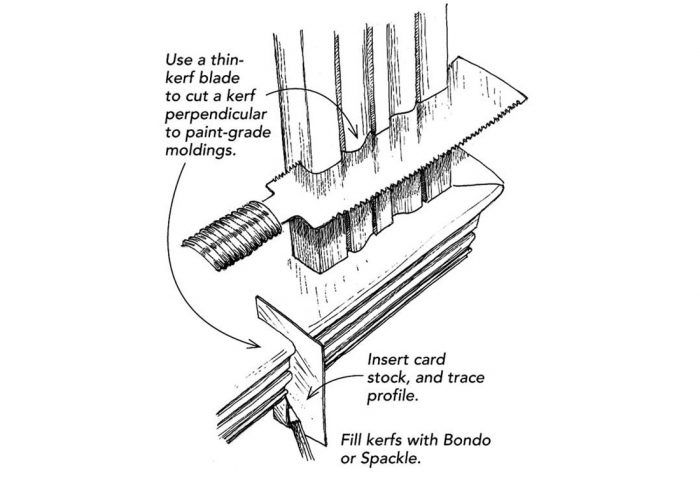Matching Paint-Grade Trim
A simple method to match the molding profile in place can be a game changer for most small trim-carpentry jobs.

Here in San Francisco, even small trim-carpentry jobs in older homes generally require reproducing one or two moldings. If I can’t remove a piece to give to the mill, paint-grade moldings can quickly be traced in place with this method.
After choosing the best example with the least paint buildup, cut across the face of the material at a 90° angle with a Japanese handsaw. The fine crosscut teeth on this type of saw won’t chip the paint.
I don’t cut all the way through the molding, just deep enough to get the full depth of the molding profile. Then I trace the profile on an index card or other stiff paper in the kerf. Ten minutes’ work with Spackle or Bondo, and I’m done.
— Gregg Roos; San Francisco, CA
From Fine Homebuilding #193
RELATED STORIES
Got a Tip?
Do you have any great tips like this one on how to match paint-grade trim like a pro? Share your methods, tricks, and jigs with other readers. Tag them @FineHomebuilding on social, email them to us at [email protected], or upload them to FineHomebuilding.com/reader-tips. We’ll pay for any we publish.






View Comments
What? Cutting into intact--and historic--moldings?
http://www.acehardware.com/product/index.jsp?productId=1292852&KPID=984950&cid=CAPLA:G:Shopping_-_Precision_Tools&pla=pla_984950&k_clickid=c5c01fa0-1320-4c1d-8757-ff54041197de
Why not just a contour duplication gauge?
You'd be done all right. Don't suppose your "Bondo" matches the paint. I can't believe anyone would cut into 100 yr., or older molding to get a match. If you are not able to figuire out how to match molding without destroying the original, find a new occupation.
Well, I’m not so worked up about the hysterics of “destroying” the 100-year old moulding, because the “copy cat” devices really don’t do a good job of capturing the subtle differences of many historic trims. It’s anyone’s guess if those writers have ever actually attempted the kind repairs/restorations covered by this tip — it sure doesn’t seem like it.
First, precision with language is a must. Here’s dictionary.com’s definition of destroy: “to reduce (an object) to useless fragments, a useless form, or remains, as by rending, burning, or dissolving; injure beyond repair or renewal; demolish; ruin; annihilate.” That’s a level of damage so far beyond the proposed action that many might call the term “hyperbolic.”
A Japanese saw’s kerf filled with Bondo, mind you the illustration clearly shows a partial cut, not a full cut, is far less than par for the filling of the normal dings of everyday life, even in that very same stick of moulding. The copy cat devices yield crap. I have seen and produced such crap despite my very best knowledge and efforts and skill to the contrary, so to the naysayers I will say that at the cost of a single thin bit of fill, I will gladly receive an actual true tracing of the profile, which will actually match.
That match is so darn close to a perfect match, that the net result of having a bunch of replacement trim actually match and improve the visual and intrinsic value of the building or space seems like a great exchange for an unseeable saw kerf.
There’s renovation and there’s preservation. Keep an appropriate perspective; mind you, the level of dogmatic preservationism raised by the previous comments entered the arena of preserving to the degree of only using appropriate period tooling for the work.
S_curvy,
Beat me to the punch, but said much better than I probably would of. Thank you.
Agreed.